Technology
PROPERTY| ROTATIONAL MOULDING
Rotational molding is an atmospheric pressure process that produces nearly stress-free parts. The fact that there are no stresses on the melt as it is shaped is a major advantage that rotational molding has over all other manufacturing methods for plastics parts. Also, as there are no forces on the plastic melt during forming, rotational molds can have thin walls and are relatively inexpensive to fabricate. For simple parts, mold delivery times can be a few days or weeks. Modern, multi-armed machines allow multiple molds of different sizes and shapes to be run at the same time. With proper mold design, complex parts, such as double-walled containers, that are difficult or impossible to mold by any other method, can be rotationally molded. With correct process control, the wall thickness of rotationally molded parts is quite uniform, unlike structural blow molding or twin-sheet thermoforming.
UNDERCUTS
Undercuts are internal or external protrusions that can impede the removal of the part from the mould. Compared to other plastic material manufacturing processes, rotational moulding is less restricted by the presence of undercuts.
This is because the moulded material is free to shrink away from to the internal surface of the mould during cooling: it could happen that the part shrinkage is equal to or more than the size of the undercut. Usually, for articles in polyethylene, positive everted undercuts with dimensions that may reach up to 50% of the expected linear shrinkage are normally considered acceptable. For flexible materials like PVC, larger undercut dimensions can be considered (for example, dolls heads are extracted from the neck zone).
More rigid materials, such as PA and PC, have less flexibility and therefore less tolerance to undercuts.
